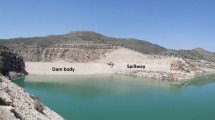Abstract
The Triassic Spearfish Formation contains numerous gypsum beds in which karstic conditions have developed in the Black Hills of South Dakota. The evaporite karst has caused severe engineering problems for foundations and water retention facilities, including wastewater stabilization sites. Two dramatic examples include the former sewage lagoons for the City of Spearfish and a proposed lagoon/wetlands facility for Whitewood, South Dakota.
The Spearfish sewage lagoons were built in 1972 on alluvium above a thick gypsum layer, despite warnings from local ranchers. At one point during construction, a scraper became stuck in a sinkhole and required four bulldozers to pull it out. The lagoons started leaking badly within a year after completion; the southern lagoon was abandoned after four years because of leaks, and the northern lagoon could not provide adequate retention time for effective sewage treatment. Attempts at repairs, including a bentonite liner, were ineffective, and poorly treated sewage discharged beneath the lagoon’s berm into a nearby surface drainage. The lagoons were abandoned completely in 1980 after a large lawsuit, and a mechanical wastewater treatment plant was constructed nearby.
The planned Whitewood sewage lagoon and artificial wetlands were proposed in 1988 at an area with troubling similarities to the failed Spearfish site. Field investigation showed gypsum outcrops within proposed wetland cells and 10-m deep sinkholes nearby. After an engineering report cited these difficulties, subsequent drilling at a proposed wetland cell showed a 9-m thickness of gypsum that was exposed at the surface. The wetlands project and later the lagoon project were tabled after controversy.
Similar content being viewed by others
References
DARTON, N.H., 1909, Geology and water resources of the northern portion of the Black Hills and adjoining regions in South Dakota and Wyoming:U.S. Geological Survey Professional Paper 65, 105 p.
DARTON, N.H. and PAIGE, S., 1925, Central Black Hills folio. U.S. Geological Survey Atlas No. 219.
DAVIS, A.D., 1979, Hydrogeology of the Belle Fourche, South Dakota, water infiltration gallery:Proceedings of South Dakota Academy of Science, v. 58, p. 122–143.
DAVIS, A.D., 1986, Deterministic modeling of dispersion in heterogeneous pemeable media:Ground Water, v. 24, p. 609–615.
DREVER, J.I., 1988, The geochemistry of natural waters. Prentice-Hall, inc., Englewood Cliffs, NJ, 437 p.
RAHN, P.H., 1996, Engineering geology, an environmental approach. Prentice-Hall, Upper Saddle River, NJ, 657 p.
RAHN, P.H. and DAVIS, A.D., 1996, Gypsum foundation problems in the Black Hills area, South Dakota:Environmental and Engineering Geoscience, v. II, p. 213–233.
RAPID CITY JOURNAL, 1978a, Raw sewage pouring from ruptured lagoon: Rapid City Journal, Rapid City, SD, April 4, 1978.
RAPID CITY JOURNAL, 1978b, Spearfish lagoons built over numerous caverns: Rapid City Journal, Rapid City, SD, May 25, 1978.
RAPID CITY JOURNAL, 1979, Spearfish officials feel big lawsuit was ‘inevitable:’ Rapid City Journal, Rapid City, SD, February 21, 1979.
STRAHLER, A.N., 1960, Physical geography. John Wiley and Sons, New York.
Author information
Authors and Affiliations
Rights and permissions
About this article
Cite this article
Davis, A.D., Rahn, P.H. Karstic gypsum problems at wastewater stabilization sites in the Black Hills of South Dakota. Carbonates Evaporites 12, 73–80 (1997). https://doi.org/10.1007/BF03175804
Received:
Accepted:
Published:
Issue Date:
DOI: https://doi.org/10.1007/BF03175804




